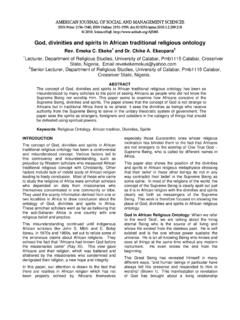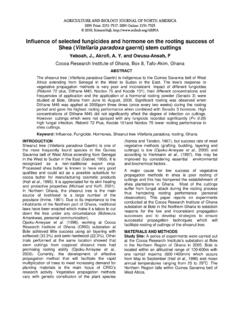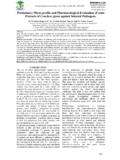Transcription of Antimicrobial, cytotoxic and antioxidant activity of ...
1 AGRICULTURE AND BIOLOGY JOURNAL OF NORTH AMERICA ISSN Print: 2151-7517, ISSN Online: 2151-7525, 2010, ScienceHu , antimicrobial , cytotoxic and antioxidant activity of methanolic extract of Glycyrrhiza glabra Shapna Sultana*1. Afroza Haque1, Kaiser Hamid1, Kaniz Fatima Urmi2 and Sumon Roy1 Department of Pharmacy, Southeast University, Dhaka, Bangladesh1 Department of Pharmacy, Jahangirnagar University, Savar, Bangladesh2 ABSTRACT The present study was undertaken to explore the free radical scavenging, antimicrobial and cytotoxic activity of the methanolic extract of Glycyrrhiza glabra (Fabaceae) using DPPH, disc diffusion and brine shrimp lethality bioassay methods respectively. Different degrees of effect was noticed incase of different methods of study. In antimicrobial screening, G. glabra showed potent antimicrobial activity against almost all the test organisms except Pseudomonas aeruginosa.
2 It exhibited highest sensitivity against Staphylococcus aureus with the zone of inhibition 22 mm. The extract possessed potent cytotoxic activity having LC 50 value of g/ml. On the other hand, the free radical scavenging activity was found moderate having IC 50 value of g/ml. Keywords: Fabaceae, disc diffusion, brine shrimp, free radical scavenging. INTRODUCTION Licorice (Glycyrrhiza glabra L., Pappilionaceae/ Fabaceae) is a well-known medicinal herb that grows in various parts of the world. It is one of the oldest and widely used herbs from the ancient medical history of Ayurveda, both as a medicine and also as a flavoring to disguise the unpleasant flavor of other medications (Biondi et al., 2005).In the traditional system of medicine, the roots and rhizomes of G. glabra (family: Pappilionaceae/ Fabaceae) have been employed clinically for centuries for their anti-inflammatory, antiulcer, expectorant, antimicrobial and anxiolytic activities (Wang & Han, 1993; Asl & Hosseinzadeh, 2008).
3 Liquorice has been shown to have great antioxidant , free radical scavenging (Haraguchi et al., 1998; Di Mambro & Fonseca, 2005) and anticonvulsant activities (Nassiri-Asl et al., 2007). It has been shown to decrease circulating levels of testosterone in men ( Rafi et al 2002, D. Armanini et al 1999, D. Armanini et al 2002). Moreover, it is reported that Licochalcone-A isolated from Glycyrrhiza root demonstrated potent antitumor properties when assayed using CaP, breast, and leukemia cells (DiPaola, et al, 1998) Isolation of various chemical constituent has been reported previously which include glycyrrhizin, glycyrrhizinic acid (Tang and Eisenbrand, 1992), glabridin, glabrene, glabrol, licoflavonol, glycyrol, licoricone, formononetin, phaseollinisoflavan, hispaglabridin A&B, 3-hydroxy glabrol, 3-methoxy glabridin (Kinoshita et al.)
4 , 1976; Mitscher et al., 1978, 1980; Saitoh et al., 1978; Fukai et al., 1996, 2002 a,b, 2003), glabranin isomer, narigenin, lupiwightenone (Biondi et al., 2003, 2005) The present study was undertaken to evaluate the antioxidant , cytotoxic and antimicrobial activity of Glycyrrhiza glabra so that it could be a guide in the discovery of new molecule with antioxidant , cytotoxic and antimicrobial property. Plant material: Glycyrrhiza glabra was collected in February 2009 from Dhaka, Bangladesh and authenticated at Bangladesh National Herberium, where a voucher specimen has been deposited. Extraction and isolation: The air-dried material (60g) was finely pulverized and extracted by percolation with MeOH for one month at room temperature. The combined extracts were filtered and concentrated under vacuum to obtain a crude extract (10g) antimicrobial activity : The disc diffusion method (Bauer et al, 1966, Rahman et al, 2008) was used to test antimicrobial activity of the extract against thirteen bacteria (B.
5 Megaterium, B. subtilis, Staphylococcus aureus, Sarcina lutea, Escherichia coli, Pseudomonas aeruginosa, Salmonella paratyphi, S. typhi, Shigella boydii, S. dysenteriae, Vibrio mimicus & V. parahemolyticus) collected as Agric. Biol. J. N. Am., 2010, 1(5): 957-960 958pure cultures from the Institute of Nutrition and Food Science (INFS), University of Dhaka, Bangladesh. Solutions of known concentration ( g/ml) of the test samples were made by dissolving measured amount of the samples in calculated volume of solvents. Dried and sterilized filter paper discs (6 mm diameter) were then impregnated with known amounts of the test substances using micropipette and the residual solvents were completely evaporated. Discs containing the test materials were placed on to nutrient agar medium uniformly seeded with the test microorganisms.
6 Standard disc of kanamycin (30 g/disc) and blank discs (impregnated with solvents followed by evaporation) were used as positive and negative control, respectively. These plates were then kept at low temperature (4oC) for 24 hours to allow maximum diffusion of the test materials and kanamycin. The plates were then incubated at 37oC for 24 hours to allow maximum growth of the organisms. The test material having antimicrobial activity inhibited the growth of the microorganisms and a clear, distinct zone of inhibition was visualized surrounding the discs. The antimicrobial activity of the test agents was determined by measuring the diameter of zone of inhibition expressed in mm. The experiment was carried out in triplicate and the mean value was taken. Brian shrimp lethality bioassay: Brine shrimp lethality bioassay (Meyer et al, 1982; Rahman et al, 2008; Hossain et al, 2004) technique was applied for the determination of general toxic property of the extract of Glycyrrhiza glabra Here, in vivo lethality test has been carried out using brine shrimp nauplii eggs (Artemia salina).
7 Eggs were placed in one side of a small tank divided by a net containing NaCl solution for hatching. In the other side of the tank a light source was placed to attract the nauplii. After 2 days of hatching period the nauplii were ready for the experiment. Four milligrams of the extract was accurately measured and dissolved in DMSO to get a concentration of varying concentrations100, 50, 25, , , , , , , g/ml. ten brine shrimp nauplii were then placed in each vial. For the control test of each vial, one vial containing the same volume of DMSO plus water up to 5 ml was used. After 24 hour of incubation, the vials were observed using a magnifying glass and the number of survivors in each vial were counted and noted. From these data, the percentage of mortality of the nauplii was calculated for each concentration and the LC50 value was determined.
8 antioxidant activity : The antioxidant activity (free radical scavenging activity ) of the extracts on the stable radical 1,1-diphenyl-2-picrylhydrazyl (DPPH) was determined by the method of Brand-Williams et al., (1995). In the experiment, mg of the extract was dissolved in methanol. Solution of varying concentrations such as 500, 250, 125, , , , , , and g/ml were obtained by serial dilution technique. 2 ml of a methanol solution of the extract of each concentration was mixed with 3 ml of a DPPH-methanol solution (20 g/ml) and was allowed to stand for 20 minutes for the reaction to occur. Then the absorbance was determined at 517 nm and from these values the corresponding percentage of inhibitions were calculated by using the following equation: % inhibition = [ 1- (ABSsample / ABScontrol)] x 100 Then % inhibitions were plotted against respective concentrations used and from the graph IC50 was calculated by using ascorbic acid, a potential antioxidant was used as positive control.
9 RESULTS AND DISCUSSION The methanolic extract of Glycyrrhiza glabra was screened against 12 test bacteria. Most organisms were found to be sensitive to the extract. However, it showed significant antimicrobial activity against Staphylococcus aureus with the zone of inhibition 22 mm. G. glabra exhibited antimicrobial activity against Bacillus subtilis, Escherichia coli but not against Pseudomonas aeruginosa. Evidence showed that due to the presence of glabrene, licoisoflavone B, isolicoflavonol, gancaonin I, it showed significant activity against these microorganisms. The antimicrobial activity of Glycyrrhiza glabra is well known (Demizu et al., 1988; Yokada et al., 1989; Haraguchi et al., 1998) and glabridin has been reported to possess antibacterial activities against some strains (Mitscher et al.)
10 , 1980; Fukai et al., 2002b). In case of brine shrimp lethality bioassay, the lethality of the methanolic extract of Glycyrrhiza glabra was evaluated against A. salina. figure-1 shows the results of the brine shrimp lethality testing after 24 hours of exposure to the samples and the positive control, vincristine sulphate (VS). The LC50 were found to be , g/ml for extract and VS, respectively. In comparison with vincristine sulphate, the cytotoxic activity exhibited by the methanolic Agric. Biol. J. N. Am., 2010, 1(5): 957-960 959extract of Glycyrrhiza glabra was significant. This clearly indicates the presence of potent bioactive principles in these extractives, which might be very useful as antiproliferative, antitumor, pesticidal and other bioactive agents. (Meyer, et al 1982, Rahman, et al, 2008, Hossain et al.











